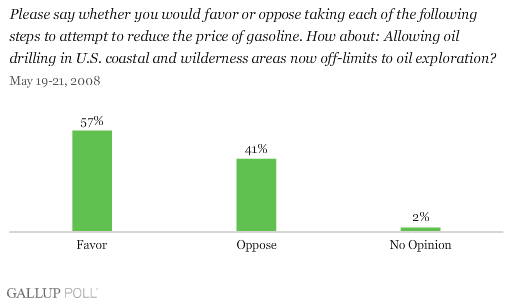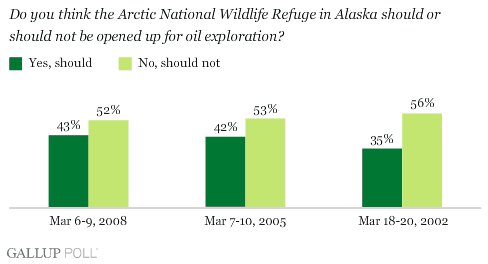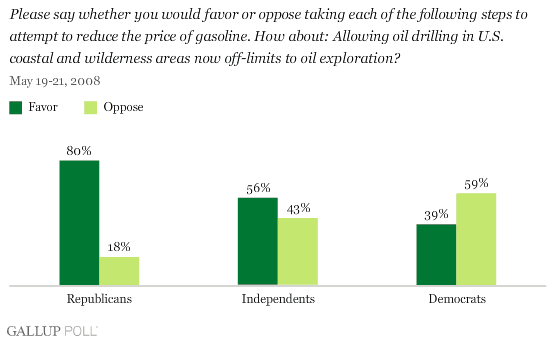PRINCETON, NJ -- A majority of Americans (57%) interviewed in a mid-May ║┌┴¤═° Panel survey approve of expanding drilling for oil in offshore and wilderness areas considered to be off-limits.

This poll result suggests that President Bush's proposals this week to end bans on drilling for oil in areas held as off-limits and for opening up leases for oil shale production in federal lands may be generally in sync with majority American public opinion.
This question about drilling in off-limits areas was asked in this fashion for the first time in mid-May and was not part of a long-standing ║┌┴¤═° trend. Thus, while we do not have a good indication of whether or not these particular attitudes have changed recently as a result of the rapid rise in the price of gasoline, they suggest a broad approval at this time on the part of Americans for expanding oil production in off-limits areas.
The current May poll result does, however, show a somewhat different attitude than ║┌┴¤═° has measured over the years in specific reference to opening up the Arctic National Wildlife Refuge in Alaska for oil exploration. A ║┌┴¤═° trend question about ANWR was last updated in March of this year.

The responses to this question show that a slight majority of Americans oppose such oil exploration.
The differences in the responses to the broad May question and the earlier question focused specifically on ANWR could reflect the difference in the wording and could also reflect the difference in time frame. The May question asked about "coastal and wilderness areas now off-limits to oil exploration" while the March question was more specifically targeted to ANWR. Furthermore, there is a two-month difference in the timing of the questions. The price of gas has risen in a seemingly inexorable fashion even in this short time period, suggesting the possibility that attitudes may have changed concomitantly.
A recent NBC ║┌┴¤═°/Wall Street Journal poll question gave respondents no less than five choices for dealing with the rise in energy and gas prices and asked them to choose the single one they most supported. The responses to this type of question do not provide information about the relative acceptability of the idea of each of the alternative proposals taken separately, but rather more simply reflect a forced-choice preference.
Still, the results show that the alternative "Open up protected areas in Alaska for oil and gas exploration" was the second most frequently chosen alternative, just behind "Encourage the development of wind and solar power."
Partisan Differences
There are perhaps predictable partisan differences in responses to the May ║┌┴¤═° question about the acceptability of the idea of opening up offshore and wilderness areas off-limits to oil exploration.

The differences are very large. Eighty percent of Republicans favor this approach, as do 56% of independents, but only 39% of Democrats agreed. These data suggest that wrangling between Democratic leaders in Congress and President Bush on the issue of lifting drilling bans may in fact reflect the strong differences of opinion among partisan groups of rank-and-file Americans on issues relating to drilling and more broadly on issues relating to the trade-off between economic development and environmental protection.
Implications
There are not yet any new survey data which speak directly to President Bush's proposal this week to end bans on drilling for oil in off-limits areas offshore and on federal lands. Although a majority of Americans in general have been opposed to drilling in the Arctic National Wildlife Refuge area over the last several years, a ║┌┴¤═° question included in a mid-May poll suggests that at this juncture in time Bush's proposals may well reflect majority public opinion. It is, of course, even possible that given the continuing increase in the price of gas in the weeks since the May poll was conducted, sentiment may have moved even more in favor of such policy changes.
Survey Methods
Results for the ║┌┴¤═° Panel study are based on telephone interviews with 1,013 national adults, aged 18 and older, conducted May 19-21, 2008. ║┌┴¤═° Panel members are recruited through random selection methods. The panel is weighted so that it is demographically representative of the U.S. adult population. For results based on this sample, one can say with 95% confidence that the maximum margin of sampling error is ┬▒4 percentage points.
In addition to sampling error, question wording and practical difficulties in conducting surveys can introduce error or bias into the findings of public opinion polls.
To provide feedback or suggestions about how to improve ║┌┴¤═°.com, please e-mail feedback@gallup.com.
